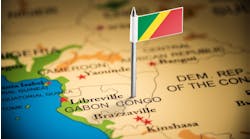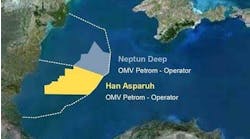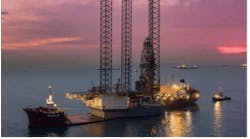Gavin Strachan,Bassoe Offshore Consultants
Uncertainty caused by recession and the attacks of Sept. 11 has ensured that caution prevails in the drilling industry during 2002.
The recent rise in the natural gas price has boosted the premium jackup market in the Gulf of Mexico, but the lower specified rigs are expected to remain in the doldrums for much of 2002. Internationally, however, things are different.
Although weak demand for oil and gas will persist in the short term, international activity is likely to be as strong as it was in 2001. The international markets are geared to the activities of the majors.
International offshore rig marketed utilization could average over 90% in 2002. However, utilization in the Gulf of Mexico might be as little as 75%, which is primarily the result of reduced natural gas prices. Accordingly, dayrates internationally are likely to remain as they are, while US Gulf rates are not expected to improve significantly until toward the end of the year.
Natural gas
Demand for gas is growing because it burns more cleanly than oil and coal, and demand will double over the next 30 years, according to a Wood Mackenzie report commissioned by the National Iranian Oil Co. The report predicts growth in the traditional North American and European markets will be boosted by rapid expansion in Asia, Africa, and the Middle East.
Natural gas discoveries in the last decade totaled 138 Bboe compared with 77 Bbbl of oil. Drilling for gas, even in remote areas, is now commercial, provided the fields discovered are large enough to support an LNG train. Natural gas is not regulated; there is no OPEC. While this encourages its production, there is no control over supply, and large swings in price will take place.
In the US, natural gas prices last year fluctuated between $10 and $2/Mbtu as a result of weather changes, fuel switching, and increasing supplies. Lower prices reduced GoM jackup drilling activity by half. Market fundamentals do not support a very strong gas price in the US in the short term, and low jackup demand will result.
Asia is the fastest growing consumer of gas. In the first half of 2001, the growth in annual gas demand in Japan and Taiwan rose by 4% and 12%, respectively, while oil consumption in both countries dropped by 1%. Jackup demand in Asia is rising as a result.
Gulf of Mexico
Jackup dayrates in 2001, including those for heavy-duty rigs, plummeted. Rates for 300-ft units dropped from about $60,000 to the $16,000-$22,000 level by the end of the year. Ten longer legged independent cantilever jackups have left the GoM as a consequence of the shortage of work. Some have moved on a speculative basis, while others mobilized against a contract. Further mobilizations should take place, particularly to Mexico, where increased demand is forecast. Other destinations could include West Africa, the Middle East, and Southeast Asia. But the number of rigs leaving will be limited, as not all Gulf-based rigs are capable of working internationally. Many have insufficient accommodation and do not carry all the equipment necessary for international operations.
Pemex plans to increase production from 3 MMb/d and 4.7 bcf/d to 4 MMb/d and 6 bcf/d by 2006. Mexico's national oil company will have a substantial program for jackups in 2002 as well as one or two semis and platform rigs. Pemex's original plan was for fifteen 250-ft and three 300-ft jackups, but it is likely that budget approval will result in the total being fewer than this. This demand is not necessarily a panacea for those with rigs in the depressed GoM jackup market, as Pemex requires accommodation for 80, ruling out many US units.
Jackups in northwest Europe mainly drill for gas and are better protected from recession if the oil price stays low. Total jackup demand in the North Sea region in 2002 looks as if it will be close to the 2001 total of 32 rig-years. Limited new heavy-duty jackup demand, and increasing heavy-duty jackup availability, is putting pressure on the top end of the market and is affecting the standard jackup market.
Asia
As a result of development activity offshore Iran and Qatar, a dramatic increase in jackup demand in the Middle East Gulf has taken place. There are likely to be 20 or more rigs working offshore Iran in 2002. Shortage of jackups able to move into Iran as a result of US sanctions has presented an opportunity for Russian and Romanian owned rigs to move there.
India consumes 1.29 MMb/d more than it produces and has an increasing demand for electricity generation. National oil company ONGC plans to double its reserves from 6 billion tons of oil equivalent to 13 billion over the next 20 years by intensive exploration in producing basins and establishing reserves in deepwater.
ONGC is set to take on an additional six to nine jackups this year. The Southeast Asian market remains strong, and there is scope for further rigs to mobilize there, mainly for LNG projects that are due to obtain approvals. China will have an increasing impact on offshore drilling. Its recent admission to the World Trade Organization will require it to find and consume energy for its export push, which it can no longer provide from domestic sources.
Rig values
Nominal values of most rig types have dropped as a result of the reduced demand. However, there are very few rigs available for sale, and values have not fallen as far as dayrates would suggest they should. This indicates that values are likely to recover quickly when dayrates rise.
Author
Gavin Strachan is director of Bassoe Offshore Consultants, providers of market intelligence on the worldwide offshore drilling industry. The company has offices in Houston, Scotland, and Oslo. Initially with UK-based drilling contractor Atlantic Drilling, Strachan became founding editor of The Financial Times World Rig Forecast in 1993 before joining Bassoe in 1996. He has an MA (Hons) from Cambridge University.








